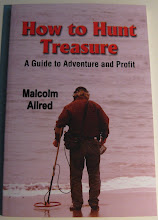Stories such as this fired my imagination, of course, and I conjectured that if there were a caisson in the Big Black, might there also be bullets and buckles and all sorts of valuable smaller relics?
Being the Plant Manager at the power plant, I could get away with a few “government” projects, so I designed and had built a 6” jet-dredge about eight feet long that was fed by a large air compressor, and which, I figured, should really pull those relics off the river bottom.
Soon, an opportune spring day arrived. Clad only in shorts, my two buddies and I towed a large gasoline-powered air compressor along with my prize dredge over to the river near the site of the defunct Mississippi town and set it to work. Amazingly, the dredge worked perfectly, spewing all manner of debris out onto our pontoon-based recovery screen. Trouble was, all we were getting were rocks, sand, branches, and square nails. Bored, I tried the underwater detector for awhile, but the water was too deep to allow scanning without scuba gear. Soon we all tired of detectors and of swishing gravel onto the screen, so one of my buddies was assigned the dredge, another was to rest and spell him, and I – I had another great idea for yanking relics off the bottom.
I had brought along a large magnet to which I fastened a piece of nylon rope, the other end of which I tied to my wrist. The plan was simple: I would drop the magnet onto the bottom of the river, float down with the current while dragging the magnet and… bingo! I would latch onto all kinds of valuable iron relics… guns, swords, maybe even a cannon!
The plan was placed into operation, downstream of my pals. The first pass or two I retrieved several valuable bent nails – no doubt thrown here by the Confederate soldiers camped all about. Another pass. More bent nails. Another pass…
It was around the fourth pass as I floated merrily down the river that I felt the line stiffen. The magnet had encountered something that wouldn’t let go. I gave the line a yank. No dice. Whatever the magnet was hung on was immovable.
Now I noticed that I was having difficulty keeping my head above water. The brisk current was determined that I was to be no exception to the laws of physics – the ones that describe how a body floundering in a river current at the end of a long length of nylon rope anchored to the river bottom must join the anchoring mechanism at the bottom of the river.
The only way I could keep my nose up was to paddle like hell, and that was rather difficult with one hand fastened to a rope. I hadn’t wanted to lose the magnet, so I had tied a good knot in the rope around my wrist; untying it would be difficult on dry land, much less out here. I knew I needed help, so I performed a series of maneuvers to attract the attention of my two buddies. It went like this: 1) Paddle like hell. 2) Raise free arm high into air and wave frantically. 3) Scream. 4) Pray.
I managed several of these complicated tactics. Each time my buddies, fifty yards upstream, waved gaily to me as I flapped my arm and yelped for help. I don’t know what the idiots were thinking, but it certainly wasn’t “Let’s save ole Malcolm.”
If I were to survive, I had to do it myself by loosening the knot in the rope. A new set of maneuvers was required: 1) Paddle like hell. 2) Work at knot before head goes under. 3) Pray. 4) Paddle like hell again.
I wouldn’t be here today if I hadn’t managed to finally loosen that knot. A dozen attempts or more were required before I finally slipped the rope from my arm; by that time I was exhausted. I swam over to the river bank and collapsed. When I was able, I walked back up the bank to where my buddies were panning gravel. They weren’t even aware that I’d just defied death once again.

That more or less ended our dredging for that day. In fact, we decided to retire my miracle dredge and return to more sane methods of relic hunting, or at least hunt streams that were only ankle deep. Later, when the level of the Big Black River had dropped to yearly lows, I employed the underwater detector to better advantage, locating a number of relics on the river bottom.
The bottoms of some of the creeks in our area have sandstone bottoms that have developed, through some strange natural phenomena, holes that vary from two inches to twelve inches diameter and two inches to twenty-four inches in depth. The Confederate soldiers and early settlers in Vicksburg apparently used these streams for drinking water and for play, for it is not uncommon to find bullets, buckles, coins, and all manner of personal items in the depths of these
 sandstone holes. During one of these creek hunts my shovel bounced off a Whitworth bolt. These artillery rounds are fairly rare, and were used in Whitworth rifles imported from England by the South; this one was apparently tossed into the creek by one of the Confederate artillerymen.
sandstone holes. During one of these creek hunts my shovel bounced off a Whitworth bolt. These artillery rounds are fairly rare, and were used in Whitworth rifles imported from England by the South; this one was apparently tossed into the creek by one of the Confederate artillerymen.



No comments:
Post a Comment